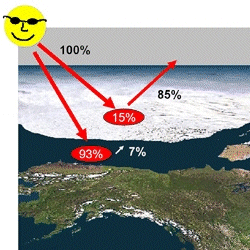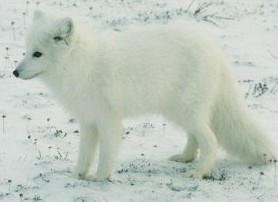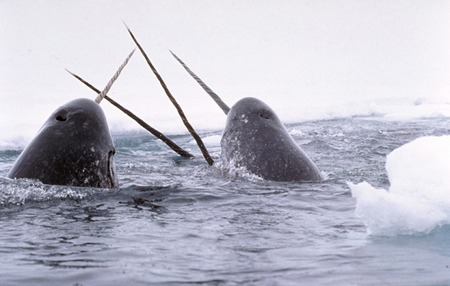5. Ice in the Arctic
Why is sea ice important?
Sea ice is frozen seawater. It floats on the ocean surface, covering millions of square kilometres. It can affect so many different things, from the global climate, to shipping, polar bears and phytoplankton.
Sea ice forms and melts with the seasons; some sea ice persists in the Arctic year after year, whereas almost all Southern Ocean or Antarctic sea ice is "seasonal ice," meaning it melts away and reforms annually. We'll look at Arctic Sea Ice in this section.

The surface of sea ice reflects as much as 85% of incident solar radiation, hence absorbing only 15%. Ocean water, by contrast, reflects only about 7% of solar radiation, absorbing 93%. This means that the ocean acts as a heat sink, whereas ice is a reflector, accelerating the warming of the planet.
Source: CRREL
Positive feedback
Sea ice is important because it reflects sunlight, reducing the amount of energy absorbed by the Earth's surface.
This energy balance determines the temperature of the Earth. It depends upon:
- The quantity of solar radiation reaching the Earth's surface
- The amount of energy absorbed and reflected
- The radiation emitted by the Earth
Sea ice extent is important due to the large difference in the amount of energy absorbed by water and ice.
Areas covered by sea ice don't absorb much solar energy at all, so temperatures in the polar regions remain relatively cool.
If sea ice melts, because of rising temperatures, fewer bright surfaces are available to reflect sunlight back into space, more solar energy is absorbed at the surface, and temperatures rise further.
Even a small increase in temperature can lead to greater warming over time, making the polar regions the most sensitive areas to climate change on Earth. This is called a positive feedback loop.
Changes to ocean currents
Water below sea ice has a higher concentration of salt and is more dense than surrounding ocean water (this will be explained two pages later), and so it sinks. In this way, sea ice contributes to the ocean's global "conveyor-belt" circulation. See SEOS tutorial Ocean Currents for more information about Ocean Circulation.
As such, changes in the area or volume of sea ice can modify normal ocean circulation, leading to changes in global climate
Fresh water from melting ice will be lighter than salt water. - Think about the effects this will this have?
Not just seals and polar bears

Source: National Snow and Ice Data Center
Too much or too little Arctic sea ice can be a problem for wildlife.
Sea ice provides a resting and birthing place for seals and walrus, a hunting and breeding ground for polar bears, and a foraging ground for arctic foxs, whales, caribou, and other mammals.
Arctic foxs have been stranded on shore with land predators, instead of being able to migrate onto the ice, where they should be.
Increasing ice is a problem for narwhals. These whales live below densely packed ice in the winter, surviving by breathing through leads and small holes in the ice. These holes can be closed by increasing ice cover.

Sea ice and the food chain
When sea ice melts in the spring it leaves behind a layer of fresh water on the ocean surface that is full of nutrients. Microorganisms use the nutrients to develop, forming the basic food stuff for organisms higher in the food chain. Another source of nutrient-rich water appears when cold, dense polar water sinks to the ocean bottom, forcing deep, nutrient-laden water to the surface, this is known as upwelling.
